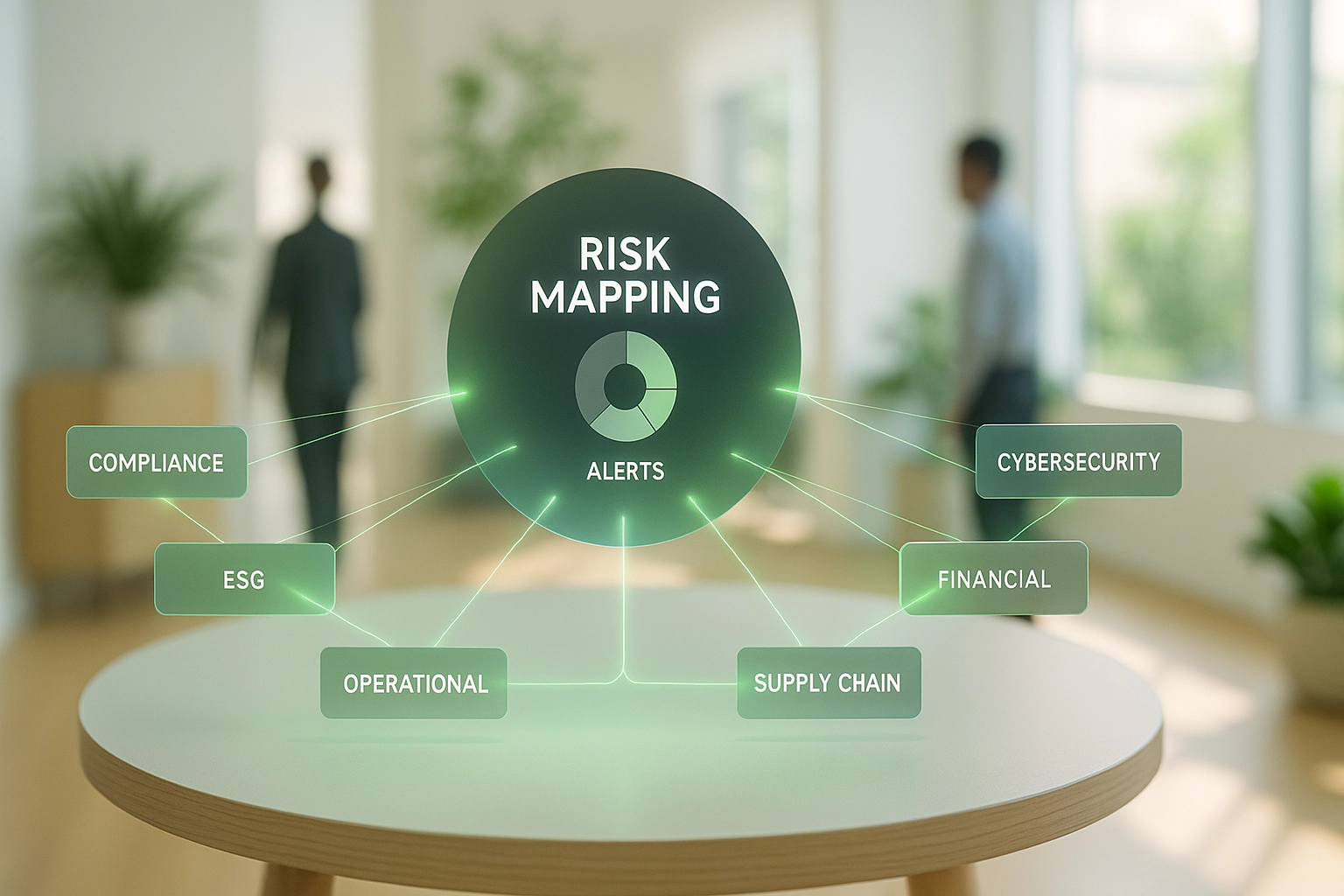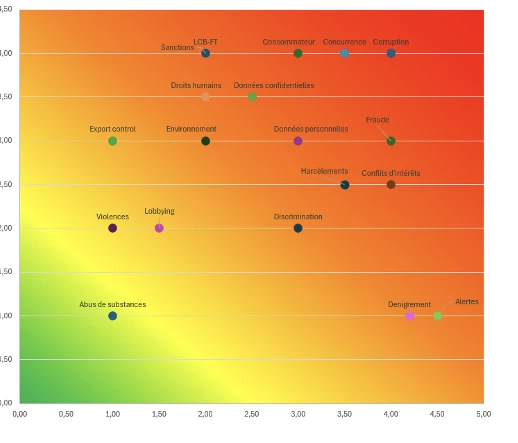Why Connecting Your Risk Mapping to TPRM Is a Game Changer

In a context where third-party ecosystems are expanding, organizations can no longer afford to manage their vendor relationships blindly. Companies are now selecting partners based on increasingly specific criteria, and many have implemented risk mapping tools to gain a clearer view of the risks posed by their subcontractors. They must actively manage third-party risks.
According to the OBSAR 2022 barometer, 46% of French companies now have a formalized risk map (compared to only 9% in 2020). Yet, the French Anti-Corruption Agency highlights that most organizations still struggle to structure effective third-party evaluation processes and to deploy a proportionate risk-based approach.
This raises a key question: why such a gap between the existence of risk mapping tools and their operational application? And more importantly: how can this gap be effectively bridged?
Risk Mapping: An Essential But Often Underutilized Tool
Third-party risk mapping aims to identify, classify, and prioritize threats that may impact the organization: corruption, cybersecurity, human rights violations, regulatory non-compliance, economic dependency… The risks are numerous and often interlinked.
In practice, however, many companies fail to unlock the full potential of this tool. Common obstacles include lack of awareness, perceived complexity, limited resources, or the difficulty of integrating it into day-to-day operations. As a result, risk maps are too often treated as static, one-off exercises—disconnected from the field.
In the public sector, this challenge translates into difficulty in evaluating subcontractors against the requirements of public procurement. Local authorities must juggle compliance with SPASER and procurement procedures, often without the right tools to ensure effective third-party governance.
The key: keep it simple. Start with accessible data and adopt a complete, actionable methodology for third-party risk mapping.

TPRM: The Missing Link to Activate Your Risk Map
This is precisely where TPRM (Third-Party Risk Management) comes into play. It doesn’t replace your risk map—it activates it.
TPRM helps orchestrate proportionate evaluation workflows for third-party partners based on the risks identified in your mapping. With TPRM, you can:
- Adapt the level of due diligence according to risk factors (country, business activity, contract amount, data sensitivity…)
- Deploy targeted, dynamic questionnaires
- Automate reminders and updates
- Cross-reference internal data with external weak signals (media monitoring, sanctions lists, alerts…)
- Visualize results in actionable dashboards
In the construction sector, this approach enables better management of multi-level subcontracting. Major contractors can evaluate providers based on site compliance, required certifications, and HSE standards—while also complying with posted worker regulations. This dynamic governance is critical to meeting decarbonization goals and managing the carbon footprint of subcontractors, where environmental risk mapping must align with operational partner assessments.
Likewise, cyber risk mapping is no longer a static document. It becomes a true decision-making engine, integrated into your operations and continuously evolving. An indispensable tool—especially for industrial firms subject to ICPE regulations and growing third-party cybersecurity obligations.
A Virtuous Circle: Greater Agility, More Reliability, Less Burden
By connecting your supplier risk mapping to your TPRM system, you can:
- Improve accuracy in identifying high-risk third parties
- Reduce the administrative burden on Procurement, Legal, and Compliance teams
- Increase responsiveness in the event of alerts or changes
- Strengthen your ability to demonstrate risk control in audits or inspections
It’s also a way to embed a risk culture deeper into operational teams—not just among compliance experts.
In the retail sector, this collaborative approach is especially valuable for managing the complexity of cross-border e-commerce. Retailers can evaluate marketplace partners against product compliance criteria, health and safety standards, and multi-country regulations—optimizing third-party risk oversight across distribution channels.
Toward Mature Third-Party Governance: The Evolution to TPGRC
The future of partner risk management lies in the evolution of TPRM to TPGRC (Third Party Governance & Risk Compliance). This transition enables organizations to fully integrate European regulatory frameworks such as DORA, NIS 2, and CSRD into a unified approach.
Third-party risk scoring becomes dynamic, adapting in real time to regulatory shifts and weak signals detected. This collaborative approach, based on secure data sharing, turns risk mapping into a true collective intelligence platform.
For industrial companies managing complex supply chains, this evolution enables them to anticipate disruptions while staying compliant with REACH and sector-specific standards.
Transforming a static risk map into operational intelligence is the real game changer: shifting from a checkbox exercise to a competitive advantage.
The connection between vulnerability analysis and TPRM is more than just technical optimization—it’s a shift from defensive compliance to proactive third-party governance. By turning risk data into actionable intelligence, you’re no longer reacting to disruptions—you’re anticipating and mastering them.
Discover how to move from TPRM to TPGRC and transform your approach to third-party risk management. Book a personalized demo to explore how to optimize your risk mapping.
These articles might interest you
-
 16 May 2025Why Assessing Upstream Suppliers Is EssentialSolutionsUpper-Tier Suppliers: The (Too Often) Overlooked Risk in Your Supply Chain Modern procurement chains rely on a multitude of actors, each contributing to value creation—extraction, manufacturing, assembly… The final product is never the result of a single supplier but rather the outcome of an often international ecosystem. Yet, most organizations still focus their efforts and […]
16 May 2025Why Assessing Upstream Suppliers Is EssentialSolutionsUpper-Tier Suppliers: The (Too Often) Overlooked Risk in Your Supply Chain Modern procurement chains rely on a multitude of actors, each contributing to value creation—extraction, manufacturing, assembly… The final product is never the result of a single supplier but rather the outcome of an often international ecosystem. Yet, most organizations still focus their efforts and […]Read more
-
 13 April 2025Automated Financial Scoring: Optimizing Third-Party AssessmentSolutionsIn today’s world of interconnected supply chains, businesses can no longer afford to manage their supplier relationships blindly. A partner’s financial health can quickly become a critical risk factor. This is precisely the view of procurement leaders, who rank the risk of third-party financial failure as their number one concern, according to the AgileBuyer study. […]
13 April 2025Automated Financial Scoring: Optimizing Third-Party AssessmentSolutionsIn today’s world of interconnected supply chains, businesses can no longer afford to manage their supplier relationships blindly. A partner’s financial health can quickly become a critical risk factor. This is precisely the view of procurement leaders, who rank the risk of third-party financial failure as their number one concern, according to the AgileBuyer study. […]Read more
-
 06 February 2025Effective Third-Party Governance: A Holistic Approach to Optimized Risk ManagementSolutionsIn a context where 38% of companies have experienced major disruptions due to third-party partners over the past three years, third-party governance is becoming a strategic imperative. This reality is even more critical as 90% of organizations now consider third-party risk management a growing priority. Effective third-party management relies on a holistic approach integrating six key areas of expertise: Legal […]
06 February 2025Effective Third-Party Governance: A Holistic Approach to Optimized Risk ManagementSolutionsIn a context where 38% of companies have experienced major disruptions due to third-party partners over the past three years, third-party governance is becoming a strategic imperative. This reality is even more critical as 90% of organizations now consider third-party risk management a growing priority. Effective third-party management relies on a holistic approach integrating six key areas of expertise: Legal […]Read more
-
 17 March 2025Understanding Third-Party Cybersecurity Maturity: Keys to Effective AssessmentSolutionsThird-party governance has become a major strategic issue in an economic context marked by the growing interdependence between companies and their external partners. According to Gartner, 45% of cyberattacks in 2025 will originate from third parties, highlighting the urgency of a structured evaluation approach. Operational resilience against these threats now requires a shift from simple […]
17 March 2025Understanding Third-Party Cybersecurity Maturity: Keys to Effective AssessmentSolutionsThird-party governance has become a major strategic issue in an economic context marked by the growing interdependence between companies and their external partners. According to Gartner, 45% of cyberattacks in 2025 will originate from third parties, highlighting the urgency of a structured evaluation approach. Operational resilience against these threats now requires a shift from simple […]Read more

